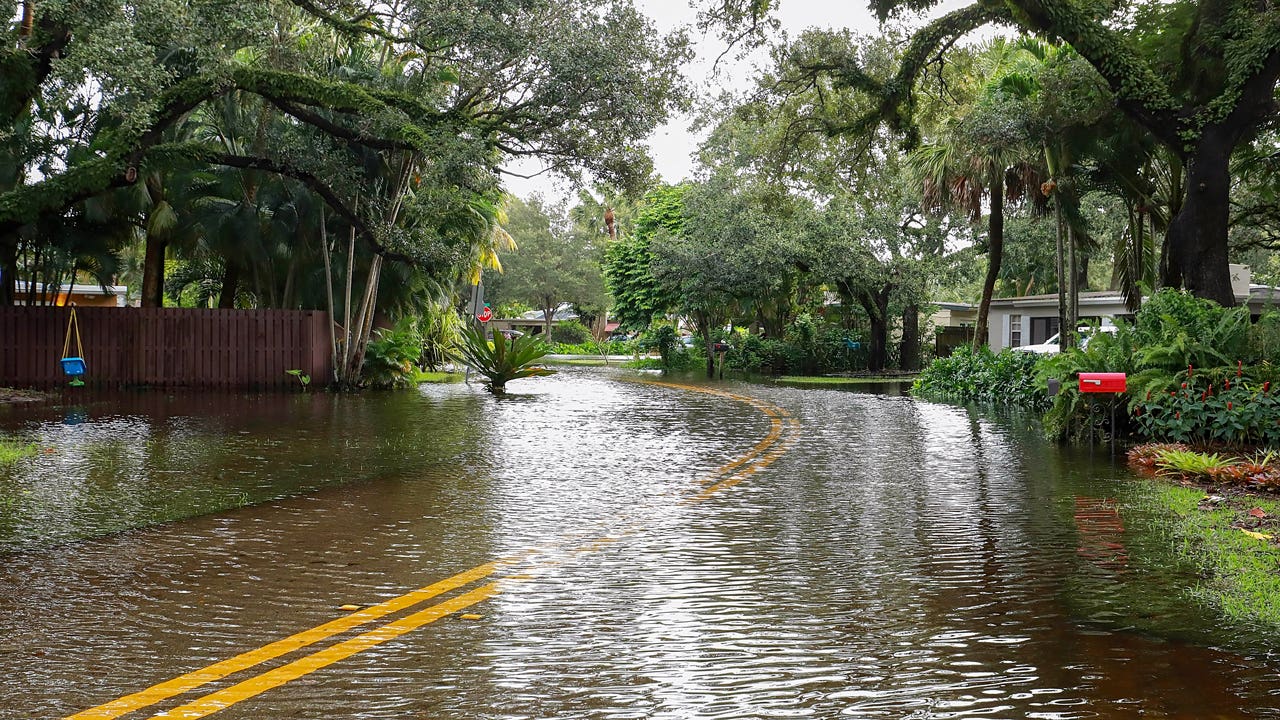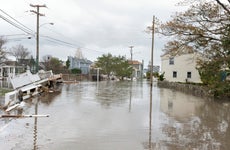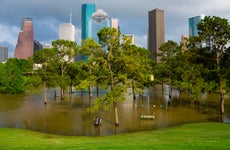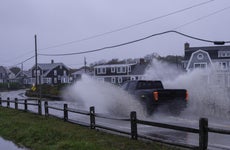Guide to flood insurance: Here’s what to know

The Bankrate promise
At Bankrate, we strive to help you make smarter financial decisions. To help readers understand how insurance affects their finances, we have licensed insurance professionals on staff who have spent a combined 47 years in the auto, home and life insurance industries. While we adhere to strict , this post may contain references to products from our partners. Here's an explanation of . Our content is backed by Coverage.com, LLC, a licensed entity (NPN: 19966249). For more information, please see our .
If your home is located in or near a flood zone, you may be concerned about potential flood damage. For many homeowners, the first step in protecting their property against flood risks is to purchase a flood insurance policy. This type of insurance is designed to cover damage that results from externally-caused flooding — flooding due to heavy rains, snowstorms, melting ice and snow, overflowing storm drains or levees, etc. — but it’s not part of a standard home insurance policy.
Fortunately, you can purchase a separate flood insurance policy or add a flood insurance endorsement to your existing home insurance policy to get the protection you need. These types of policies can generally be purchased through a private carrier or the National Flood Insurance Program (NFIP). However, there are some unique features and caveats to know about flood insurance policies. To ensure that your flood insurance meets your personal needs, it’s important to understand what exactly a flood insurance policy covers and how it works.
- Floods are the most common natural disaster in the U.S., and just one inch of water can cause $25,000 in damage to your home.
- A standard homeowners insurance policy does not cover damage caused by flooding.
- Flood insurance may be required if you have a government-backed mortgage and live in a flood zone.
- You typically have to pay a flood insurance policy premium in full when purchasing.
- Most flood insurance policies have a 30-day waiting period before your coverage takes effect.
What is flood insurance and how does it work?
Flood insurance is typically sold as a standalone insurance policy that covers the structure of your home and personal belongings from flood-related damage. Flooding is defined as an overflow of water onto land that is typically dry, but flood policies do have some exclusions. Mudslides, for example, are not typically covered by flood insurance.
Having flood insurance may be beneficial because flood-related losses are not covered under traditional homeowners, condo owners or renters insurance policies. Flood insurance policies are offered through the National Flood Insurance Program (NFIP) and some private insurance companies. However, a few homeowners insurance companies, such as Kin, offer flood coverage as an endorsement that you can add to your existing home insurance policy.
When you buy flood insurance, your policy does not take effect immediately. There is typically a 30-day waiting period before you can file a claim. However, this period could be waived in a few scenarios, including if you need flood insurance to close on or refinance a home, or if your home has been included in a newly designated flood zone within a certain timeframe.
What does flood insurance cover?
Flood insurance policies from the National Flood Insurance Program (NFIP) come with two types of coverage: dwelling coverage and contents coverage. Here is what’s covered:
- Dwelling coverage: This is the backbone of your flood insurance and is mandatory to purchase a policy — you cannot waive your dwelling coverage. Dwelling coverage provides financial protection from the damage that flooding can cause to the structure of your home, built-in appliances and attached structures. If you get NFIP coverage, the dwelling insurance portion of your policy is capped at $250,000, regardless of the market value of your home.
- Contents coverage: Contents coverage covers your personal belongings, including your clothing, furniture and home decor, up to your policy limits. This is optional coverage and you can purchase NFIP flood policies without personal property coverage. NFIP policies cap contents coverage at $100,000.
Private insurance companies may offer more policy options, higher dwelling and contents limits, and different flood insurance rates compared to the NFIP policies. You may find that you can purchase different coverage or higher coverage limits with a private carrier than you can with the NFIP, which could provide more peace of mind during flooding events.
Another benefit of private flood insurance is that policies can often be activated within 10 days or less, versus the 30-day waiting period for NFIP plans. Although you should keep in mind that private carriers may impose a moratorium if there is an impending storm or other major weather event. As with home insurance, getting quotes from a few different private flood insurance carriers can help you find the best flood insurance for your needs at the most affordable price.
What is not covered under flood insurance?
Like home insurance policies, flood insurance policies have exclusions. These may include:
- Damage caused by moisture, mildew or mold that could have been prevented
- Damage caused by earth movement, including mudslides
- Damage to outdoor structures, like decks, patios and pools, and landscaping
- Additional living expenses if you are displaced due to flood damage to your home
Because flood insurance is designed to cover damage caused by true floods, your policy might not cover sources of internal water damage, such as failed sump pumps or burst pipes. These types of accidental and sudden water damage might be covered by your home insurance policy, depending on the additional coverage you have.
I have homeowners insurance. Is that enough?
Homeowners insurance, condo insurance and renters insurance policies may offer protection for plumbing-related water damage and water leaks, but they will not cover losses due to naturally occurring floods. This is because flooding can be devastating to a region.
Many private insurance companies are not structured to withstand the financial responsibility of paying out claims in such large amounts. To ensure the ability to pay flood damage claims, insurance companies would have to increase home insurance premiums significantly.
Although you may think your area is relatively safe from flooding, the Federal Emergency Management Agency (FEMA) reports that 99% of all U.S. counties had experienced a flood event between 1996 and 2019. The average NFIP claim payout for flood damage is $52,000.
Flood insurance is usually only required in specific circumstances, such as getting a mortgage on an ocean-front vacation home. However, flood coverage can be a good investment, even if you aren’t terribly concerned about the risk of flood damage. You might consider flood insurance if:
- Your home is in a flood zone, and you have a government-backed mortgage. Mortgage companies will likely require flood insurance in this case. It is worth noting again that flood insurance premiums are typically due in full upon purchase.
- Your home is in a high-risk flood area. You can check your flood risk using FEMA’s mapping tool. If flooding is common or likely in your area, buying a flood insurance policy could be a good idea. Remember that there is typically a 30-day waiting period, so you probably don’t want to wait until there is a storm that could cause flooding in the forecast.
- You do not have the finances to repair flood damage. Even if you are not in a flood zone, your property could still flood. If you do not have the finances to repair your home or replace your belongings after a flood, you might want to consider a flood insurance policy.
Types of flood insurance
Previously, the only way to purchase flood insurance was from the NFIP. However, in the last several years, some private carriers have started to offer flood insurance.
When it comes to private flood insurance vs. NFIP coverage, understanding the differences between the programs could help you determine the best flood insurance companies to request quotes from.
National Flood Insurance Program (NFIP)
The National Flood Insurance Program gives homeowners access to federally supported flood insurance. NFIP insurance is available to any homeowner, regardless of flood risk, and offers up to $250,000 in building coverage and $100,000 in contents coverage.
If you own a business, you can purchase an NFIP commercial policy with up to $500,000 in building coverage and up to $500,000 for contents. For both residential and commercial flood policies, these coverage types generally have separate deductibles and may need to be purchased separately.
Flood policies may be issued directly by the NFIP or by various insurance companies through an NFIP program called write your own (WYO) policy. With the WYO program, the insurance company issues and services the policy. However, the NFIP is responsible for paying any approved claims related to the policy.
Private flood insurance
Private flood insurance also covers the structure of your home and its contents from flood damage, except it receives no support from the federal government. Instead, private flood insurers are companies that either rely on a reinsurer or money collected from premiums to cover losses.
Private flood insurance policies can be more robust than NFIP policies, and you might have access to more coverage options and higher policy limits than you do with federally underwritten policies. Additionally, waiting times for private flood insurance might be shorter than the 30-day period NFIP requires.
How much does flood insurance cost?
The average annual cost of flood insurance through the NFIP was $700 in 2019. However, in October 2021, FEMA began using its Risk Rating 2.0 program, which takes various factors into account when determining premiums. The program is designed to close the price gap between lower-value and higher-value homes and more accurately rate an individual property’s risk of flood damage.
If you opt for coverage through a private insurer, rates will vary by company. In addition, the price for your flood insurance will depend on several factors, including:
- Flood zone and flood risk
- Home age and construction
- Coverage limits
- Deductible level
In many cases, you are required to pay your flood insurance premium upfront and in full each year. However, if you add a flood insurance endorsement to your existing home insurance policy, the premium will likely be added to your home insurance premium, which you can pay on a monthly basis.
How to lower the cost of flood insurance
While flood insurance can be expensive — often more expensive than the cost of your home insurance policy — the Risk Rating 2.0 system is expected to lower the cost of flood insurance for some NFIP policyholders. You may also be eligible for a discount if your community participates in the FEMA Community Rating System (CRS). This means that your community has created flood management programs beyond the NFIP requirements.
There are other steps that may help lower your premium, whether you obtain a policy from the NFIP or a private carrier. It may be possible to lower your premium by:
- Adjusting your policy limits and deductible
- Providing an annual elevation certificate
- Retrofitting your home to minimize damage in the event of a claim
Additionally, requesting a quote for flood insurance coverage from more than one carrier or adjusting the policy limits could help you find a flood insurance policy that falls within your budget.
Frequently asked questions
-
-
Flood insurance doesn’t vary as much as homeowners insurance does, but the best flood insurance company for you will still depend on your individual wants, needs and circumstances. Homeowners in high-risk flood zones might have different coverage needs than homeowners in lower-risk zones, for example. Additionally, some homeowners may want coverage for their personal property while others choose to forgo that option. Talking with a flood insurance agent and getting quotes from both private carriers and the NFIP could help you find a policy that is right for your situation.
-
Flooding can be devastating, so you should consider insuring your home to its replacement value to help protect your finances from the danger of having to pay for repairs out of pocket if possible. While you can opt out of personal property coverage, it may not be the best choice for you. The cost to repair or replace your belongings after flood damage will not be covered unless you purchase contents coverage. It’s worth noting that NFIP policies have a $250,000 property maximum, which may leave some homeowners far short of replacement coverage. If you aren’t sure how much coverage to purchase, you could consider reviewing your needs with an insurance agent, who might be able to help guide your decision.
-
It depends on what has caused the flooding and the specifics of your policy. If your basement flooded due to a sump pump failure, flood insurance would not cover it, but your home insurance might if you have a water backup endorsement. The NFIP prohibits and excludes basements in new construction in high-risk areas. Because basements are at a higher risk for severe flood damage, you should talk to your agent and read your policy carefully to determine coverage.
-
If your home or personal belongings are damaged in a natural flood event, you should file a claim with your insurance carrier as soon as possible. Once the claim is submitted, an adjuster will be assigned to the case. The claim adjuster will probably visit your home to survey the damage in-person and determine what repairs are necessary. Then, the adjuster will calculate your insurance settlement. If you have a mortgage, your lender will get a check for the cost of repairs to your dwelling, but you will get compensated to replace your personal items. Depending on the nature of the claim and your insurance company, it could take several weeks to a month (or longer) to receive your claim settlement.
-
Related Articles



